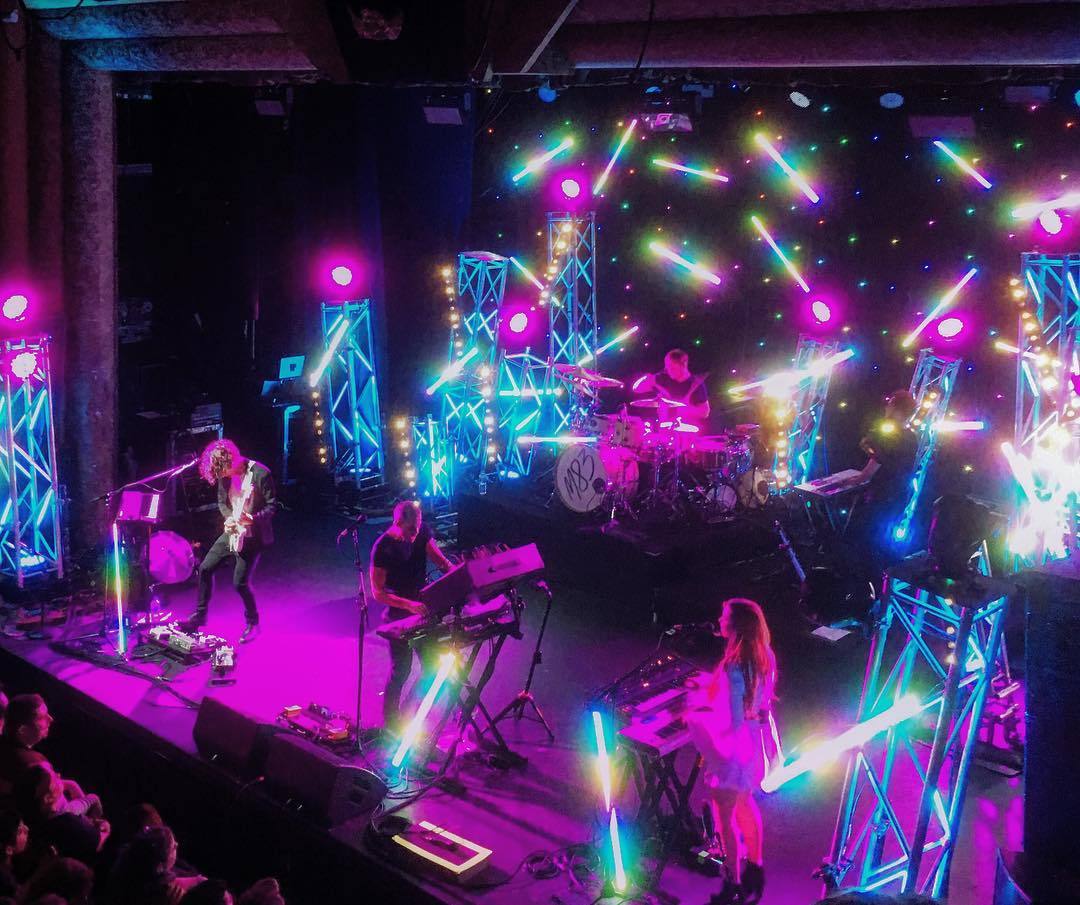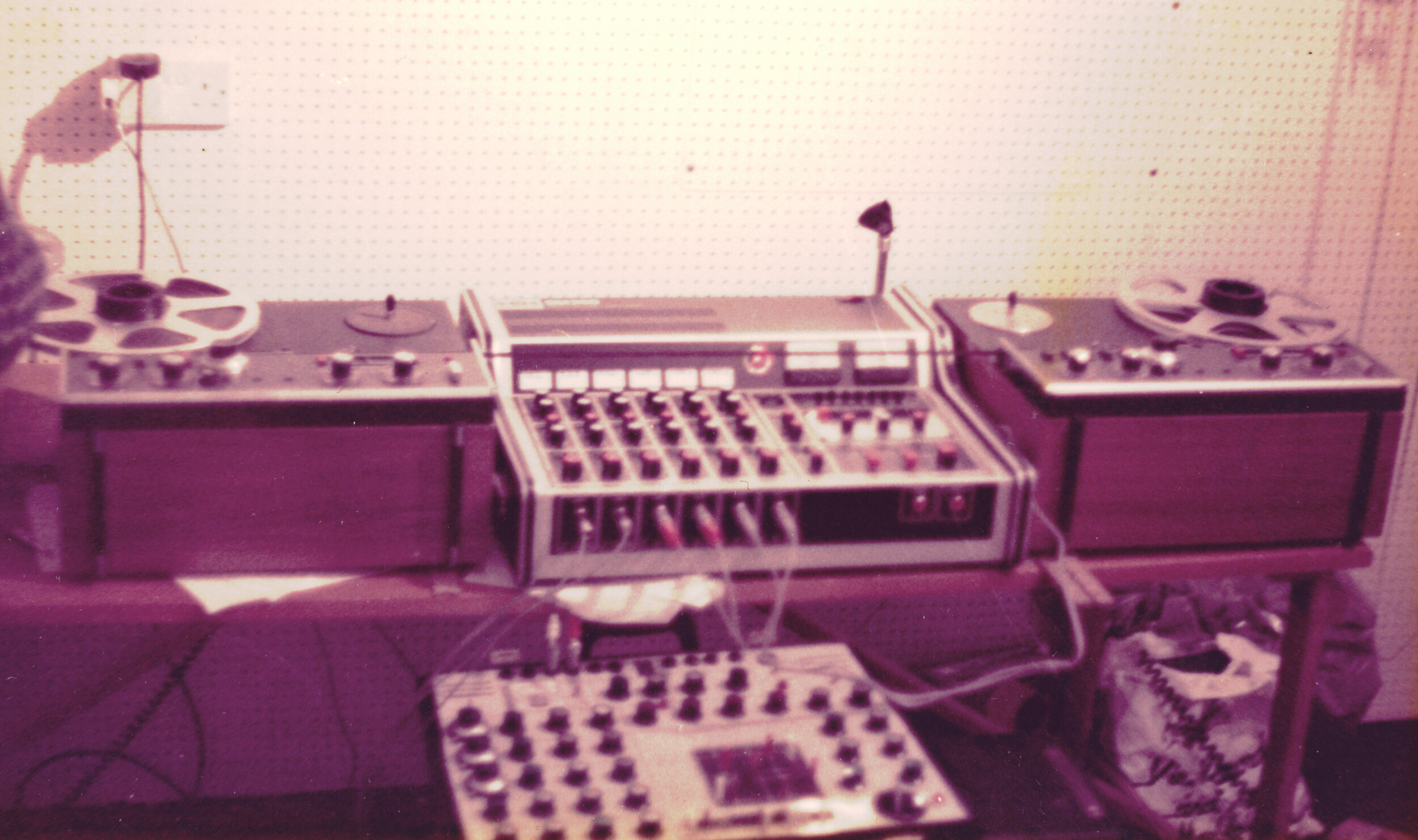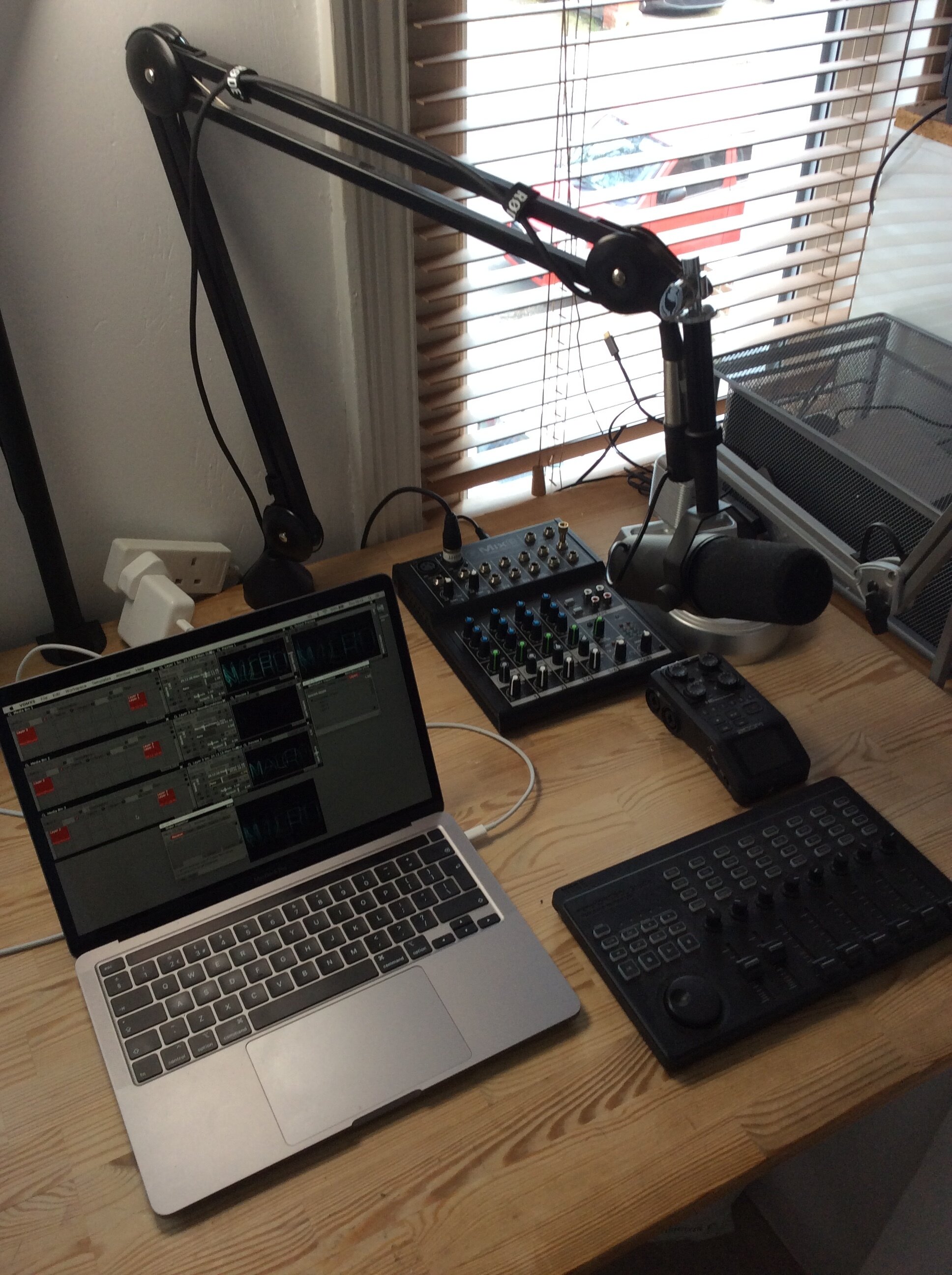The first in a new series of conversations from VIDVOX, hosts David Lublin and Cornelius (ProjectileObjects) sit down with artists Anton Marini (Vade) and SarahGHP to talk about breaking machines, analog history, and the art of making your own tools.
Read MoreAkra Kinari Performance in Sydney Harbour
Grey Filastine & Nova: Akra Kinari
"Our work has always spoken about the disfigurement of nature... but there was still way too much use of polluting airplanes," explains musician and multimedia artist Grey Filastine. Faced with this creative and ethical dilemma, he and his partner Nova embarked on an audacious journey: they turned a traditional sailing vessel into Arka Kinari, a carbon-low, seaworthy vessel for their audiovisual performances. Part art installation, part tour vehicle, and part home, the project represents a complete fusion of life and creativity. We sat down with Grey to discuss the genesis of this incredible undertaking, from the practical need for better sound systems in remote Indonesian islands to the grand vision of a truly sustainable artistic practice. Read on for a look inside this "tiny floating universe."
Read MoreSONICrider “painting with sound”
Who is SONICRIDER - Jurgen Winkel?
Jurgen Winkel
Artist – Producer – Musician – Performer (SONICrider, BLIND, LSDice, The Phonons, …)
Who are you, and what do you do?
I’m Jurgen and in love with sound and vision as long as I can remember, when I hear sounds I “see” visuals and when I see visuals I “hear” sounds.
Sound wise I started recording music from the radio with a cassette recorder on the primary school and it became a collection where synthesizers played an important role, Pink Floyd was the favorite. The next step, record little parts of the recorded music on a second cassette recorder, modulating the speed and the love for sounddesign was born.
Visual wise I got fascinated by natural “art”: sleeping outside for the first time as a kid discovering the stars and universe, walking along the sea studying the rhythm of the waves, traveling by train while the world passes by. Later on I cooperated this fascination creating visuals where the natural flow is the red line.
During my study in Eindhoven I met a guy who performed with poems; I told him that I heard sounds in my head supporting his words. The band BLIND was born and became a industrial, rock, electronic duo band: we toured from mid eighties till mid nineties in Europe, released a couple of albums and live we used 8 mm movies (filmed by us) as part of the stories we told.
BLIND live
Beside BLIND I began sound design for local artist, dancers and movie makers, slowly I got a massive sound archive that I didn’t use for the projects. Creating tracks using that archive became SONICrider.
As SONICrider I use modular and DIY gear as main instruments creating from ambient till experimental techno: when I play live I use visuals like we did with BLIND. I constructed my modular gear like members of a band: drums, bass/guitar, synth, percussion, sounds, each case can be used stand alone when I do collaborations:
– LSDice: experimental acid/dance (David plays 2 MC 505’s)
– The Phonons: ambient jazz (Siem plays a bass guitar)
– Gijs van Bon (a light artist): I create live sound touring with his installation where a 2 weeks visit on Taiwan playing at a light festival was a fine high light.
– Several one time collabs.
Since the C-virus ruled the world I zoomed in on (which I did occasionally) creating visuals, telling stories. Some of those visuals are presented at festivals around the world where I as musician probably never would have attended in person.
Modular music is very suitable making (ambient) drones that exceeds regular playtime: it was hard to find a label releasing this tracks. So I started EAR (Emotional Analog Resonance) and at the moment there are 33 monthly releases done.
Living from the music I create is sometimes hard so projects like mixing (sometimes live), mastering, lessons in synthesis and organizing modular events are a welcome add.
What tools do you use?
It all started with 2 cassette recorder and tools to manipulate the speed. The machinery I used in BLIND was a Roland 909, 2 AKAI samplers (one with keyboard and midi), Roland drum pad and a Roland Juno 60.
Hardware stayed the main source creating most of my music where working in the box mostly is mastering tracks. In the box arrangements as “commissioned art” are a second path using Ableton manipulating recorded pieces from my hardware or field recordings.
SONICrider live
Searching for a visual ad while playing live I use Ableton, VDMX and DMXis (light control); these visuals are part of the expression, “the story I tell”. Using VDMX opened a world of opportunities manipulating the visuals with the live sound: via an UAD interface I use sound filters to control VDMX. The visuals move from abstract to real material all shot by me. “Although electronic music uses sampling a lot, I always use own material, it feels like it should be”.
VDMX pushed me in a creative direction to start with a visual and add sound/music as a “soundtrack”, slowly entering the world of short movies, an exciting exploration.
The mentioned hardware is a collection I built over 40 years and in the studio the early gear is there still working well. Beside Tape recorders, Moog synths, other hardware (drumcomputer, synths, DIY instruments), modular gear is the core. The cool thing about modular gear is the fact you can built a new instrument for each project like a painter creates new colors.
“The Sound And Vision Lab” in the center of Eindhoven is the homebase creating music and visuals, carry out mix and master jobs, coach and teach: sounddesign, synthesis, Ableton, VDMX and creative thinking. The studio is ready all the time to stream a live performance solo or with friends/musicians.
The Sound And Vision Lab
Tell us about some of your recent and upcoming projects!
I recently released an album on ” Cyclical Dreams (Argentine)” called ” A Mental Reset”. This second album of a trilogy drive the mind into a reset “we need to act to keep our planet a healthy, peaceful and safe place. The first album of this trilogy (also released by Cyclical Dreams) called “ELAPSUS” or “escaping” which we try but cannot. The last of this trilogy (2027) “Future Proofed” will be created in thoughts over the coming months and then converted into tracks.
SONICrider – A Mental Reset
Most of the tracks/albums by SONICrider are released indecent on the SONICrider label via Bandcamp or via small third party labels around the world. I released over 300 tracks and have the feeling this never stops 🙂
Playing live is special and give energy like nothing else, so on regular basis a selection of gear hits the road playings gigs/festivals in Europe. A special trip was a 2 week tour in Taiwan playing live sounds as past of a light art work where water, light and sound meet.
And yes, visual releases using VDMX is an ongoing path, sometimes as a (live) stream from “The Sound And Vision Lab” or as prerecorded movie for festivals around the world.
SONICrider – Deconstruction Of A Dream (for the Cyclical Fest 2024)
Every now and then SONICrider plays a live set on a local radio as the start of a “electronic radio sow” and on a more regular basis I organize modular events in Eindhoven. This foundation “Modulab Eindhoven” has asmission “Liberating Electronic Music”, during the afternoon there are workshops, at the evening 3 performances by international artists and in between some vegan food.
As mentioned before EAR established by me, is a label ocussing on non-commercial electronic music. EAR releases should take listeners on a journey of experimental, industrial, ambient soundscapes where the playtime exceeds “regular” releases.
What drives me?
Finding a balance between the past and the future where the now is key. Caring and sharing a peaceful, healthy and save place for everybody no matter race, religion, gender, age by listening what others thinks, having respect for other opinion and be yourself. Life is short. Act you should!!
All my life I feel sad when violence hits people and unfortunately “history repeats itself” war is around us and in Europe a topic…. As an artist I can contribute with music supporting those who suffer as I human being I try the stand for Peace, Love, Unity and Respect #PLUR.
Release by SONICrider supporting Ukraine:
Entering the ’60 (age wise) I keep on doing what I did the last 40 years, expressing my view via music by “Painting with Sound”.
Take care, Jurgen
Some Links:
– SONICrider website
– SONICrider YouTube
– SONJCrider Linktree (all links)
– EAR label
Codie in Madrid, 2019, photo by Westley Hennigh-Palermo
Interview with Sarah GHP!
For this artist feature we are joined by software developer and live video performer Sarah Groff Hennigh-Palermo to talk about how she got started with feedback loops, finding your own aesthetic style, and a whole lot more. You can also check out her guest tutorial that takes an EXTENSIVE behind the scenes look at her current Eurorack and live coding rig!
Who are you and what do you do?
My name is Sarah Groff Hennigh-Palermo, but since that is very long, I usually go by Sarah GHP.
(Early Codie Stills, 2019)
I do live visuals with my bands Codie (me & Kate Sicchio), Cable Knit Sweater (me & David Miller), and Electric Detectives (me, as Hue Archer, & Nancy Drone). Codie is more live code focused, with Kate and I building up a set from scratch with code, whereas Cable Knit Sweater is more modular focused, and David and I share signals across our rigs. Electric Detectives is somewhere in the middle. And then I make more fixed video pieces, from silent sketches to scored collaborations, like Pleco.
I also wrote a zine manifesto about computer-critical computer art with the folks at Nonmachinable that I am very proud of.
I focus a lot on improvisation and bright, gritty textures, and a lo-fi aesthetic. For me, this is a form of aesthetic resistance to the way computers are being deployed in the world. When we look at all the cute, dirty things old computers can do, or when we look at the neat things we can invent with open technology, we start seeing alternatives to all the smooth, coercive technology the world is filling up with.
What tools (hardware, software, other) do you use in your creative / work process?
Cable Knit Sweater in Nevers, France, 2022, unknown photographer
My primary tools are La Habra, a Clojurescript + Electron framework I wrote to live code SVGs; VDMX; and a Eurorack case with the LZX TBC2 and LZX Memory Palace inside, along with other useful modules. I also have a Fairlight CVI, a digital-analog synth from the 1980s, although I do not perform with it because it is gigantic! The Memory Palace is inspired by the CVI and although it is a lot more limited, it is a lot more portable.
Sometimes I also use Signal Culture's applications, especially Framebuffer and Interstream, or write one-off manipulation tools using p5.js.
To transform video signals throughout the system, I use a lot of Blackmagic converter boxes. (I go into these in more detail in my how to.)
A Blackmagic Hyperdeck is useful to record both computer and synthesizer output. Gitlab saves my code, so I can remember where an improvisation ended at least.
An old CCTV camera or two are nice to have on hand for rescanning, which can be either a useful replacement a series of converters or used to capture glitchy footage that a converter will overcorrect. For people interested in video signals, I found them confusing for a long time, so I wrote up my notes, which might be helpful.
In your guest tutorial you describe how all of the various pieces of gear and software you are using all fit together, such as different techniques for video feedback. How do you go about trying out new things to find your own unique visual style and do you have any tips for people just getting started?
Sarah GHP in San Francisco, 2023, photo by Westley Hennigh-Palermo
Hm, that is a very good question. I think I was very lucky in that I had a definite aesthetic in mind when I started. It has changed a bit, but having a direction to aim for was helpful. I knew I loved two-dimensional polygons, a pop approach to color and pattern. That is partially nature — I just think about aesthetics a lot — and partially nurture — I grew up in Southern California, which is a land blessed by color and kitsch and fun, and then spent years in every modern art museum I could. So the Disneyland meets Lygia Pape vibe already was deeply embedded into my imagination.
Then in terms of further exploration, I would say I have a pretty constant push and pull between deliberation and happy accident. When I first started doing live code shows, every time I would encounter something I liked out in the world, in a museum or an ad or at a show, I would try to think about what a similar thing in La Habra would be like. Since I was trying to practice every day at that point, I could usually try it out pretty quickly and see what I liked. But then deliberation ended — I did not think about trying to capture it all — and I am sure I forgot like 50% of what I found out, but that is fine with me. If it is important, I will find it again.
Discovering feedback as a tool also worked in a similar accident–deliberate–accident structure. I had applied for a residency at Alfred University with a former member of Codie and then she couldn't go, so I went alone and spent the entire time working on video stuff. (Accident.) They had a Fairlight CVI and when I was running through a bunch of modes, I happened to hit one of the feedback presets when running a video of my work that had a background which just happened to match the chroma-keying, and the footage was amazing. (Accident.) But I couldn't replicate it the next day, because I did not understand it. So I went through all the modes (with the help of my husband Wes, who often serves as a studio assistant) and captured what I could to take it apart and try to understand it at home. This has taken years, and the purchase of a Fairlight, and I would say I understand a lot more. (Deliberation.) Then I do another round of improvisations and explorations where I might start with a question or intention, but inevitably get sidetracked or make a mistake, and then open up a whole new vein. (Back to the accidents.)
(La Habra + Interstream, 2022)
And then VDMX was the same. I started using it to route Syphon signals, tried out some effects for fun and had some quick wins, and was baffled by others. So I took some footage from an improvisation and systematically applied every effect in VDMX to it. Not only did I write down notes here, but I recategorized all the effects in my notebook by how they affected the kind of footage I make.
So have a goal, have a bunch of happy accidents, and then try to understand things so you can recreate the accidents. You will have more accidents and grow your list of things to understand.
For me, too, understanding actually means two things. It means understanding technically what is happening but also understanding where the outcome lives, aesthetically or art historically. For instance, I find it useful to be able to think about gritty visual dislocation and feedback in terms of, say, 90s design and Raygun magazine. This gives you pointers as to where to look for more inspiration and can help direct collaboration. The typography in my zine with Nonmachinable comes directly from this.






So, I guess my advice is:
Look for your starting point. What do you actually like? What do you like that isn't what everyone else likes? Being a bit of a hater (in your head!) is also a good way to find a starting point. Don't be mean, but it is useful to know what you do not want to do, especially if you aren't sure what you want to do.
Go out and fuck up a lot.
Find a balance between exploration and deliberation. Don't try to save everything because you will drive yourself mad.
Focus on understanding and avenues will open up around that.
Tips / suggestions for people looking to find live code shows / getting more into that community?
Codie as astronauts in Limerick, 2020, photo by Antonio Roberts
If you are in New York City or nearby, then I can recommend Livecode.NYC wholeheartedly. It is a friendly community, which puts on a ton of shows, often at Wonderville, in Bushwick.
Otherwise, TOPLAP has an event calendar, a list of nodes, and a Mastodon instance. Once you start getting to know folks from one scene, it is pretty to meet those from others.
Tell us about your latest round of touring in Europe and the US, and anything coming up next that you'd like to hype!
Sarah in Berlin, 2023, photo by Westley Hennigh-Palermo
Ha, well I am not sure I would call anything a tour. I am always trying to balance wanting to play more and having a day job and other hobbies, like swimming and improving my German.
I got my start in the US live code scene, being around for the early days of LivecodeNYC, so when I was back in the States in December I played with the SF A/V Club and then did a chill evening with my New York friends. Every city's live code scene is different and something I really treasure about New York is that there are still corners where the experimental DIY vibe can flourish.
And speaking of good vibes, in May, I did a talk, anti-AI meme workshop and Cable Knit Sweater performance at Art Meets Radical Openness, a biennial conference run by Servus.at in Linz, and then played with Codie at Blaues Rauchen in Essen. Both were impeccable.
Coming up, I will teaching a workshop at NØ SCHOOL NEVERS, a summer school in Nevers, France, and then Cable Knit Sweater will play again at the festival on the last weekend, July 12 to 14.
After that, not much planned for performances, but in the future, I really would like to do some durational — 6- or 8-hour — gallery performances, where the piece can evolve slowly, so anyone in Europe reading this who is interested, should talk to me.
Looking to find more from Sarah GHP? Check out her website, follow hi codie on Instagram, and watch the guest tutorial showing off her live video rig!
‘assimilating' - Photo by S20
Mapping Festival 2024 interview with Hiroaki Umeda
One of the performers at Mapping Festival 2024 was the choreographer / dancer Hiroaki Umeda who performed their dance piece Median. Sadly our team didn’t arrive in Geneva until the following week, but fortunately we were able to connect with them over email for a quick interview!
1. Who are you and what do you do?
I am a choreographer, dancer, visual artist from Japan, based in Tokyo. Most of my dance pieces, I do choreography, composing the sound, visual design. As extension of my dance pieces, I also make visual installations.
2. What tools (hardware, software, and other) do you use in your work?
For sound creation, recently I have changed to Ableton Live. For visual creation, programmers in the production team use different tools such as Touchdesigner, openFrameworks, houdini etc. For the operation of dance performance, Logic X, Max, VDMX and Touchdesigner.
3. Tell us about your latest performance at Mapping Festival!
The title of the piece was ‘Median’ that is solo dance piece with video projections. I myself dance in the piece. The concept of the piece was choreographing micro scale visual materials and human body. As a choreographer, I have ambition to choreograph cells or some micro scale objects. From that, I made this dance performance. The programmers used a lot Voronoi program with Houdini and oF.
‘Median’ - Photos by S20
4. Can you tell us about your process for designing videos to use as part of dance? Does one come before the other?
First setting basic concept of show, key visual and key choreography. It is like parallel processing. For me designing visual materials including lighting, costume and etc is a part of choreography.
5. You have been working in this area for more than 10 years, what things have changed and what things are still the same about your workflow?
At the beginning of my career 20 years ago, I did all elements of the creation, sound, visual and choreography. with the time, the programming had gotten more and more complicated and specialized. So I needed to work with programers for visual elements and engineers for other technical parts like sensors. That was about 10 years ago. But recently, I see the softwares and programming have been developed a lot and designed more for wide range users. I can easily use sophisticated and complicated program by myself. For the latest my dance piece, I did all the creation like my beginning of my career by myself with Touchdesigner, Ableton Live and Azure kinect thanks to all the developers!
Want to see more work from Hiroaki Umeda? You can find them on YouTube and on http://hiroakiumeda.com
Lighting and visuals for m83 in Brisbane
Who is the legendary Sarah Landau?
The circles of lighting designers for tours is surprisingly tight knit, and one of the names that will keep popping up is Sarah Landau. Along with being one of the most talented production designers and performers in the game right now, she’s also great found a way to find some balance between the worlds of nonstop touring and getting to enjoy life, which anyone who has done it will tell you is no easy task. When we first met Sarah back in 2013 she was on the road with Passion Pit and already well established as one of the top up and coming LDs in the game – since then she’s worked with m83, Grimes and a bucket full of other amazing musicians… and now we’ve finally gotten hold of her for a minute between jumps for a quick interview about her latest gigs and world travels!
Read MoreArt and projection mapping with Lucinda Dilworth.
Lucinda Dilworth, a digital artist following her Greek origins, is aiming to evolve as an artist to suit the modern and technological-driven world.
Her fusion of creativity, innovative thinking, and a deep understanding of the digital landscape sets Lucinda apart and drives her to push boundaries and explore the intricate relationship between art, technology, and artificial intelligence
Read MoreVideo and Light: an Interview with Derrick Belcham
Derrick Belcham is a Canadian filmmaker based out of Brooklyn, NY whose internationally-recognized work in documentary and music video has led him to work with such artists as Philip Glass, Steve Reich, Laurie Anderson, Paul Simon and hundreds of others in music, dance, theater and architecture. He has created works and lectured at such institutions as MoMA PS1, MoCA, The Solomon R. Guggenheim Museum, The Whitney Museum Of American Art, Musee D'Art Contemporain, The Philip Johnson Glass House, Brooklyn Academy of Music and The Contemporary Arts Center of Cincinnati. His work regularly appears in publications such as The New York Times, Vogue, Pitchfork, NPR and Rolling Stone as well as being screened at short, dance and experimental festivals and retrospectives around the world.
Who are you, and what do you do?
I’m a multi-disciplinary, collaborative artist that generally focuses on moving images of some kind or another. I’ve made hundreds of films in performance documentary and traditional “music video”, but I usually use VDMX for the fun stuff… experimental and live productions. Particularly, I love using VDMX for its audio-reactivity tools with video files and DMX lighting systems.
With it, I built the lighting and projection design of three of my large-scale immersive productions in the 60,000 sq ft behemoth of the Knockdown Center a few years back, the last with 300+ custom lighting heads all triggered to the sound of musicians and actors inputted into VDMX. It’s a really amazing environment to map out and deploy the technology of a piece, and allow for so many indeterminate, playful outcomes as you do.
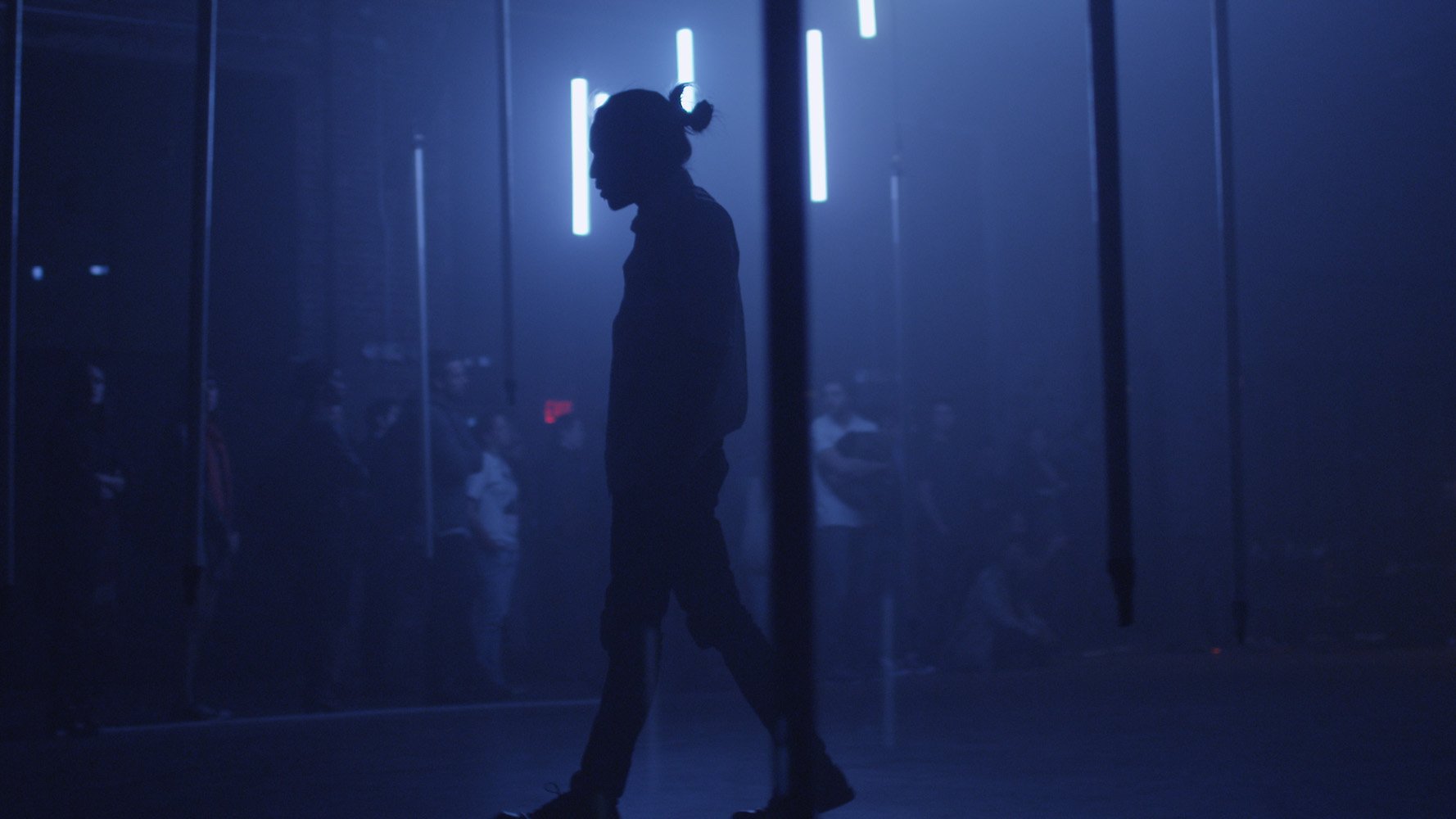
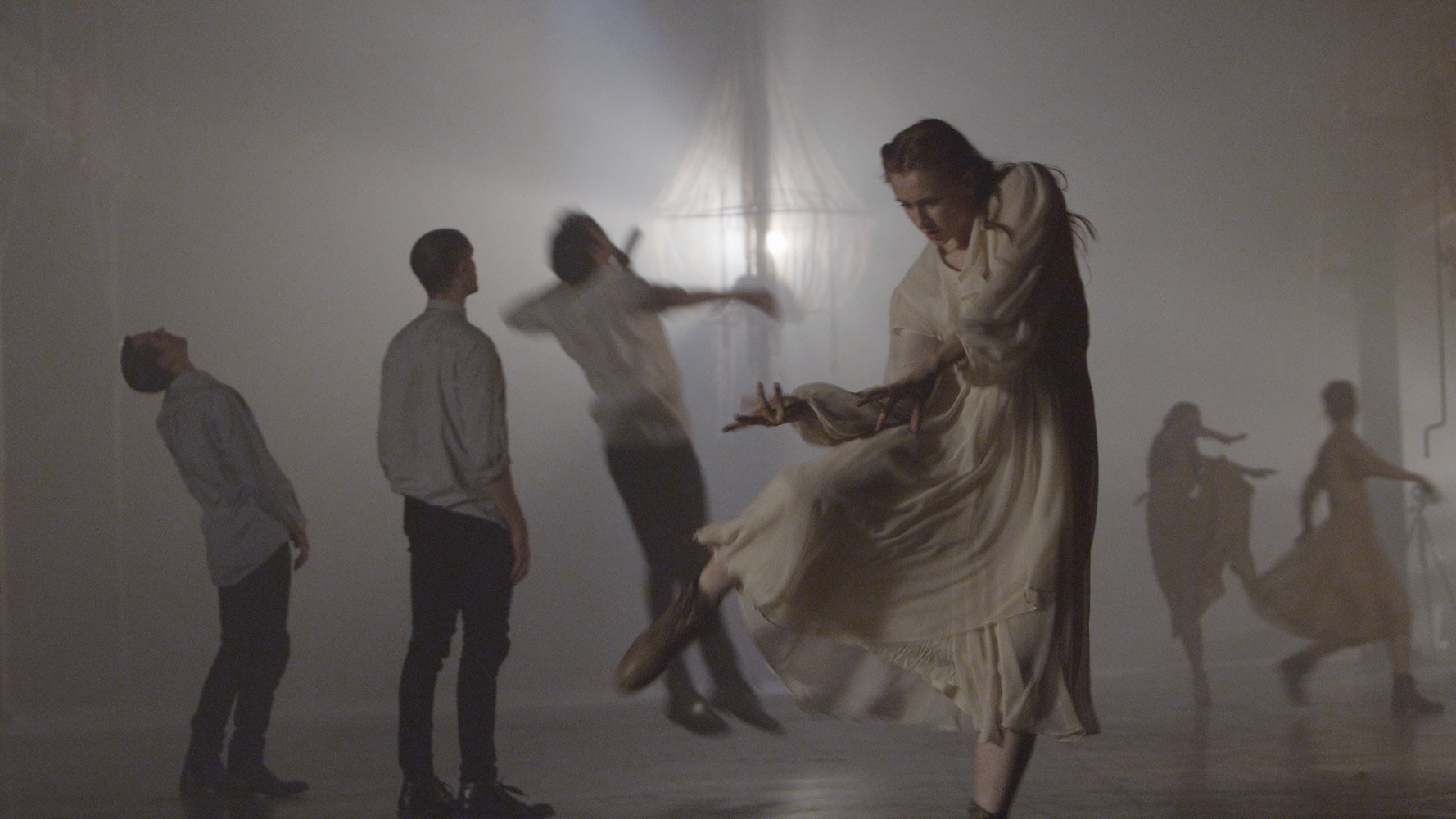

What tools do you use?
I like a combination of analog and digital tools in my process, or else the feeling of “transience” gets a bit too prevalent for me… I like to start with a notebook and pen with most things, imagining then designing specifics of a system. Sometimes a very specific image will appear, and then the process would be working backwards through a set of problems that allow me to reach that vision.
I use Red digital cinema cameras and Leica R glass (digital + analog marriage made in heaven) along with a Fujifilm GFX 100S for stills on the digital side, and then a Braun Nizo 8mm and a number of weird/wild 35 and 120 cameras on the purely analog side. I have a lot of different filters, pre-made and homemade, for certain effects and really like to try and keep as much as possible “in-camera” before it makes its way onto the computer.


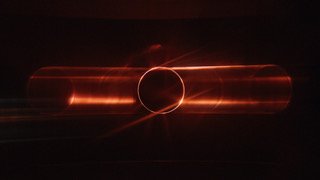
With VDMX, my essential is an ENTTEC DMX interface and various dimmers and controllers to create custom shapes alongside traditional lighting heads. I use projectors quite heavily as well along with even haze to conjure all those Anthony McCall-type ephemeral shapes…
Last year, I made two projects with Bing & Ruth for the release of their latest, Species. David is an old friend, and I wanted to design a system in VDMX that he could operate almost like an EMS Spectron or one of the super early oscilloscope visual synths… I set up two stacked projectors in my darkened studio, hazed it to Irish winter dawn levels and put David in front of a set of knobs and sliders that shifted the shape, opacity, color and speed of the outputs from VDMX. A camera faced these shifting, volumetric rays and then displayed them in an inverted monitor (also in VDMX) so that he could “play” along to his song in realtime. The final video is one, unedit sequence of David’s visual performance.
Past Work:
I’ve utilised VDMX as the driver/processor of the lighting and video-reactivity on videos with Dave Gahan, Julianna Barwick, Blonde Redhead, My Brightest Diamond, Simon Raymonde and so many more the last 10 years that I’ve been using the program.




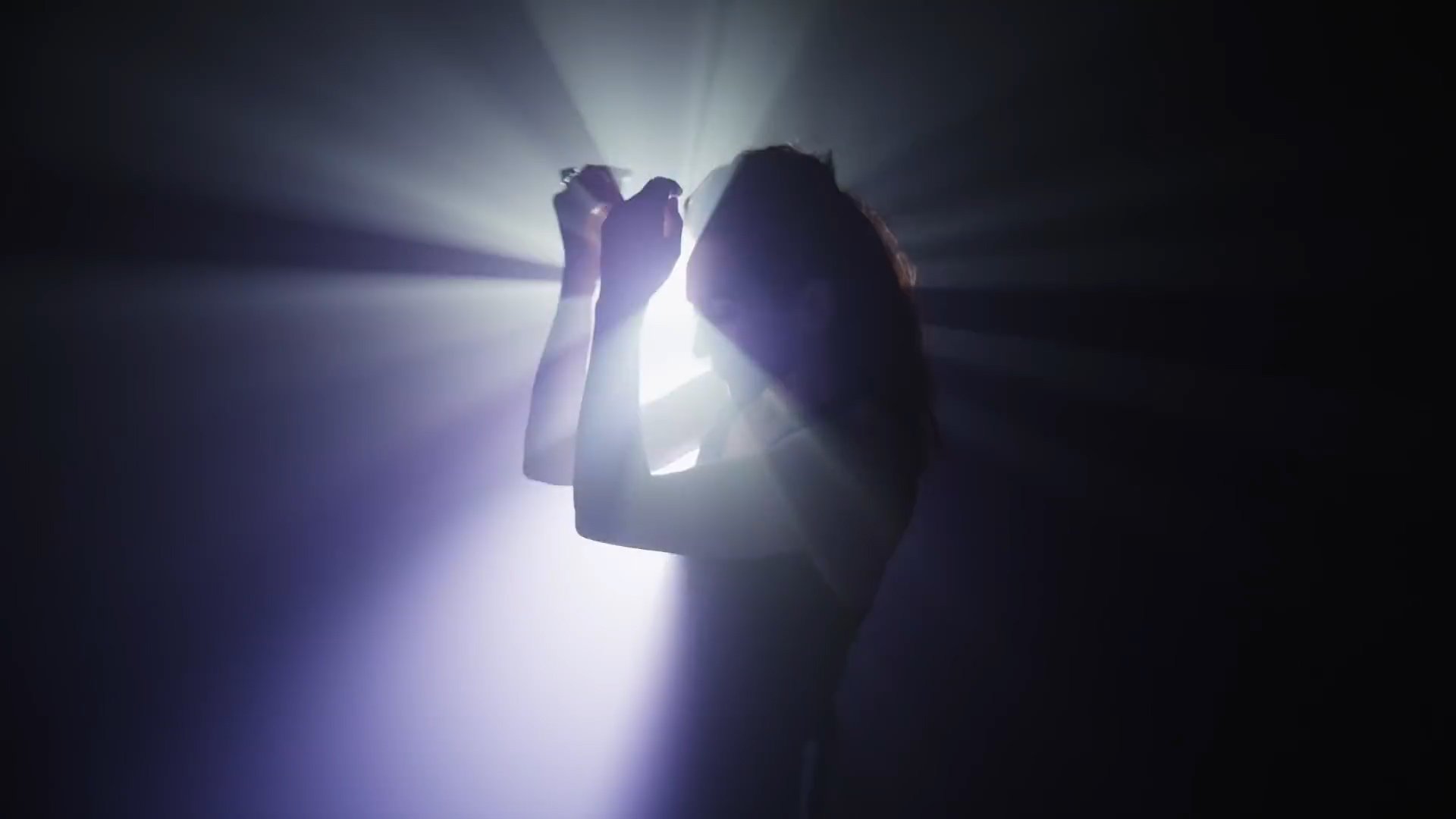
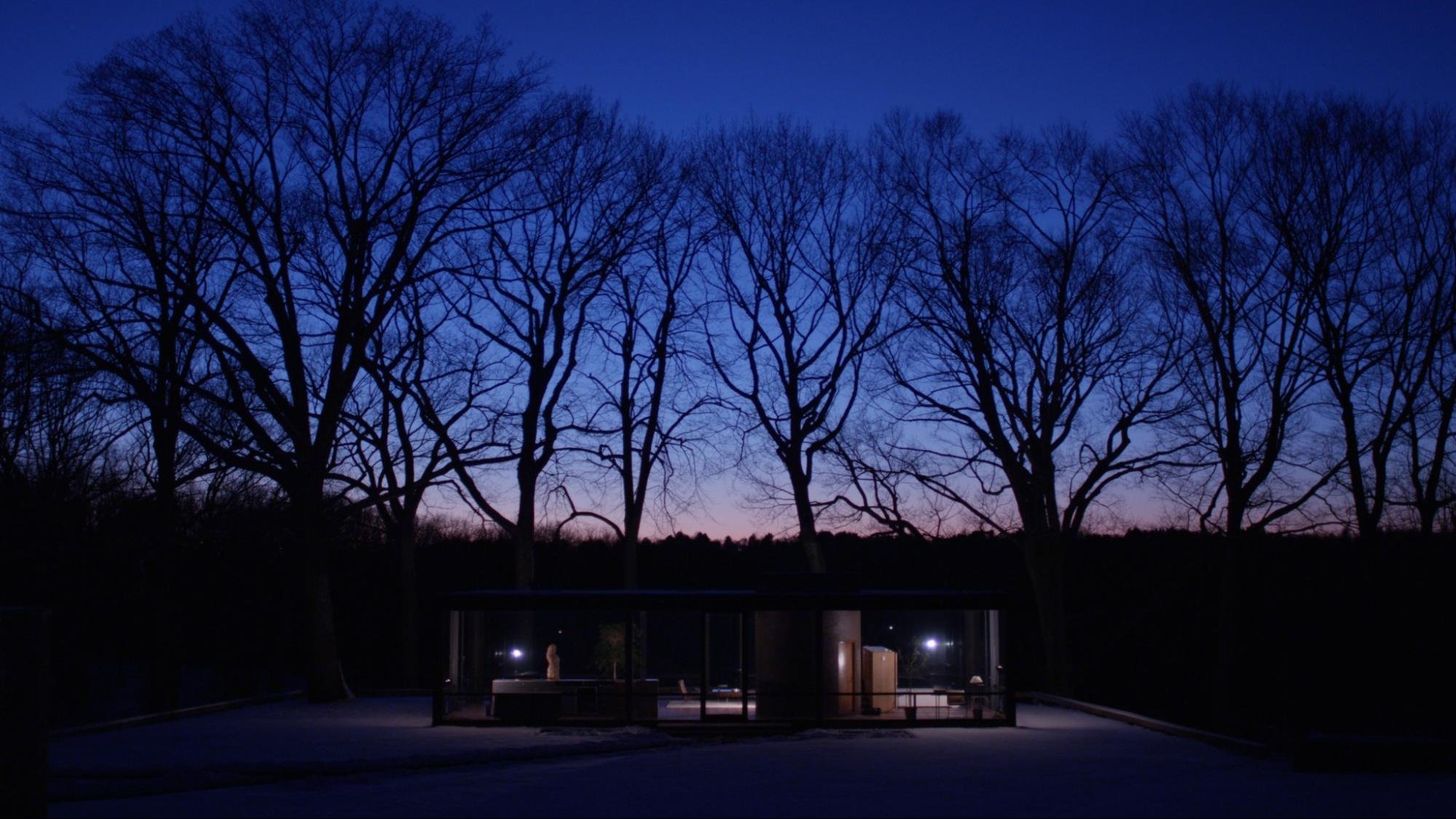
You can see them all at derrickbelcham.com
Recent and Upcoming Projects:
This last June, I went to Iceland to collaborate on two new pieces with Bergrun Snaebjornsdottir and Þóranna Dögg Björnsdóttir which took me all over the island collecting visual samples from the natural environment. As I went, I took photos of instances of pareidolia any time they hit me (faces in the rocks, symbols in the clouds, etc) and came back with a large repository. For a new art-metal project with Brooklyn composer Brendon Randall-Myers, I decided to mix those with the movements of a fantastic dancer named Jacalyn Tatro using a new sound-reactive process in VDMX. (That comes out this month, so I’ll send the link when it’s public! Sneak peek images here…)


Beyond that, I’m in the process of designing a new theatre piece fully within the VDMX environment that will use the performers visual and auditory input as the source for a kind of large-scale looping playground… very excited to keep experimenting with that these next few months. I love the power that the program has, but also how invisible it can be within a live production… it is such a beautiful thing when the audience can be held in a space of unknowing when it comes to the mechanisms of the illusion.
From Analog to Digital with Paul Kendall
An interview with Paul Kendall, a composer, producer and visual artist.
From the past to the present, Paul Kendall has a career innovating music and sound. We caught up with him to get his story and talk about his evolution into the visual frontier with VDMX.
I come from a free jazz/ musique concrète beginning to a sound engineer/ mixer middle, culminating in a deafish composer/ visual artist attempting the final writes!
Between 85-97 I helped set up a series of studios for Daniel Miller’s Mute Records in London. I worked as the in-house engineer contributing in varying degrees to artists: Depeche Mode, Wire, Nick Cave, Nitzer Ebb, Barry Adamson, Renegade Soundwave etc.
Also during my time at Mute I established a sadly short-lived label devoted to experimental electro-acoustic music, The Parallel Series.
Basement demo studio in Covent Garden, London, 1979. Technology too expensive so with 2 friends we used a couple of Revox 2 track tape-machines, a basic console and a WEM Copicat our only outboard effect.
Home demo studio London 1984. Technology relatively affordable, 16 track Fostex Tape Machine, Allen & Heath 16 input console, DX7 synthesiser, Drumtraks Drum Machine, unseen but there Great British Spring Reverb, Time Matrix 8 tap digital delay. Soon I added BBC Micro Computer running UMI midi sequencing software.
My first musical/ hardware love was the tape recorder; around 1960 when I heard the simple slow down/ speed up possibility of an early 3 speed reel to reel, so it was sound more than music which fascinated me, but a total pipe dream as was most of the interesting technology in the 60’s and 70’s. I settled with a tenor saxophone and making noise was finally between my lips. A brief stay at University of York allowed me to learn the Revox tape machine/ tape loops/ VCS3 synthesiser but once again on return to London access to technology was limited. I had a job for 9 years in a bank so I was able to fund setting up a small studio with 2 friends to learn basic band demo recording using two 2 track machines and bouncing between them.
In 1984 following the sudden death of my mother I decided to leave the bank and with a small inheritance bought the new very affordable Fostex B16 16 track analogue tape machine, Allen and Heath mixing console, a BBC Micro Computer based sequencer UMI, a Yamaha DX7 synthesiser, Drumtraks drum machine, and most importantly an 8 tap digital delay unit called Time Matrix (almost an instrument in itself, a dub persons dream) and finally a Great British Spring Reverb.
I locked myself away to learn and experiment and as good fortune happened Daniel Miller knew of my endeavours and asked me to help setting up a similar facility for the Mute artists to demo and the lesser known artists to record masters.
The studio developed over the next 20 years or so into a fully functioning 24 track facility. At the end of 1990 I became aware of a significant new development from America the arrival of computer based digital audio. It was the moment where I fully embraced the binary world, bought a MacIIcI computer with Sound Tools/ Digidesign software for the first time enabling audio to be edited/ copied/ reversed/ EQ’d/ processed all within the digital domain. This may seem facile in the face of the acceleration of technology available today but back then the affect was considerable.
Mute Main Studio London 1988. Named, Worldwide International. Studio Design by Recording Architecture, Photo by Neil Waving. This was the 2nd studio for Mute which I was involved in and was my home for the next 9 years. The first was based on my home studio, image 2, and was on the top floor of Rough Trade in Kings Cross, London.
Mute Programming Suite London 1988. Named, The Means of Production. Studio Design by Recording Architecture, Photo by Neil Waving. A second studio at Mute used initially for artists wishing to experiment and prepare their work before using the main studio.
One of the areas which benefited from digital audio and which liberated my approach was remixing. It was possible to perform lots of dub mixes on the console bouncing to DAT (previously the costs involved with analogue tape would have been prohibitive). These mixes could then be loaded into the computer and edited, this was a perfect example of performance/ dub being integrated into a final mix.
Since this period and until very recently my work was almost exclusively based on a Mac and Pro Tools or Logic software. However due to severe hearing/ frequency loss over the last 10 years I have been unable to pursue sound work creation on computer as with many digital processes it is possible that spurious ‘noise’ could be generated and I would be oblivious to it.
Refocusing I decided to revert to my earlier love of musique concrète so just using mechanically generated sound, springs, bits of metal etc. and using guitar pedals to process, so no computer involved. In addition to this I started experimenting with visuals, whilst my eyes still function!
I was searching for a method to work with visuals as I worked with sound. I began using a macro lens on my camera zooming in on small details of an object which is an equivalent of taking an existing sound and microscopically messing with it. I looked around for suitable software which could process the visuals and add a degree of performance too. This is when I discovered VDMX. I could slow down/ speed up/ reverse/ superimpose/ manipulate/ texturalyl shift visual material exactly the way with audio, and with the addition of a Korg NanoControl I could perform dubs on the visuals, great result. This set up has served me well for a couple of years and will continue to do so. Obviously I am a novice in the visual field which is in some ways liberating as I have never learnt the ‘rules’. The adage with sound; if it sounds right it probably is right can be applied to visuals/ light or so I maintain!
Home studio London 1990. Fully embracing the just available digital workstation from Digidesign. Originally called Sound Tools before evolving into Pro Tools. My set up was on a Mac IIcI, DAT machine, Atari 1040 running Creator midi software.
Home studio West Sussex 2021. In some ways this is the most powerful and tiniest set up of all. Mac Book Pro running Logic Pro, Final Cut and of course VDMX! Peripheral equipment: Shure SM7B, 8 channel mixer, Korg Nano Control studio, Zoom H6 6 track digital recorder.
Back last May after isolating since the beginning of March (my partner had Covid very early on) I was searching for some creative inspiration and got hold of a couple of iPad apps which process sound. I spent 3 intense days experimenting and improvising using springs and things and voice as source. These improvisation morphed through editing to a series of coherent pieces of music/ noise. An album, Boundary Macro, from these will be released on vinyl later on in the year on Downwards Records and published through a return to Mute Song. So far I have finished 3 videos to accompany the album all made with VDMX.
You can see more visual work from Paul on Vimeo or follow his Instagram. And if you’re curious to learn more about VDMX, visit our tutorials page to get started.
Behind the scenes: Sam Wiehl's visuals for Ladytron
In a previous very awesome blog post we interviewed Sam Wiehl and collaborator Luciana Haill about PZYK SKAN, an amazingly cool EEG Controlled Sound and Visuals project. This week we are extra excited to have Sam back to tell us about more about his background as a live visual performance and show off his latest work for the infamous band Ladytron!
Read MorePLASTIKMAN live Guggenheim NY 2013. Photo Igor Ribnik.
Exploring the visual architecture of Ali M. Demirel
Once again we are fortunate to have an interview with one of the visualists who has been working in this field even longer than us. Ali M. Demirel originally studied nuclear engineering and architecture, lectured at GISAM (Audio-Visual Research Center) of METU, and began creating experimental videos in 1993. Since then he has worked with some of the legends of electronic music, performed at some of the worlds most impressive venues, and continues to make mind blowing work.
Read MoreStuart Warren-Hill on Coldcut, Hexstatic, Vjamm, and his latest projects Holotronica & Hologauze!
Over the years we been lucky to have some amazing pioneers in the field of live visuals join us for artist interviews to share their experiences – now added to that list is Stuart Warren-Hill, who has been working at pushing the boundaries of what is possible and continues to do so with his latest projects. Today we will find out a bit about his infamous history and get a glimpse into where he is taking things next.
Read MoreThursday Night Music & Light
Some Thursday Night Music & Light with Andrew Juris
Along with getting to talk to VJs and visual creators about their own amazing work, we sometimes find out about all kinds of cool events happening all over the world. Today California based artist Andrew Juris is here to tell us about a weekly Thursday Night Music & Light in Berkley that you’ll want to check out next time you are in the area!
Read MoreProjected fun from Projectile Objects
I’m Cornelius Henke III, also known as ProjectileObjects.
Most of the projects I work on are in the realm of film/video, but over the last decade, my interests have spread. (Projection mapping masks, VJing, LED light sculptures, etc.) I think most of the work I do fits somewhere in the category of a creative technologist. The natural progression of my work was from Music Video Creator/Director -> VFX & Motion Graphics -> VJing/ Projection Mapping -> “Creative Technologist” / Video Producer/ Editor.
Read MoreImage from Meta-7 by John Sully, XIX Collective and MojoVideoTech
Mojo Video Tech gives us a behind the scenes on Meta-7, a new collaboration with XIX Collective and John Sully
We’ve been emailing with MojoVideoTech for about 15 years now, and his career goes back well before that… a full in depth interview is long overdue, but today we’ll have to settle for a quick behind the scenes of his latest project Meta-7, which is playing through May 18th, 2019, and you can still get tickets.
International Sound Artist John Sully teams up with XIX Collective and MojoVideoTech to present, META-7 (an alchemic opera). Audience members lay on a sub-bass vibrating floor surrounded by a 7.1 sound system inside a 360° video mapped dome. The story is about all of us. Where do we come from? Why are we here? Where do we go after? Very much inspired by Sully’s album listening parties when he was a kid in the 70s, META-7 is a gesture towards the sacred and mysterious through a deep immersion of sound, light and architectural design. There will be 4 shows per night at 7,8,9 and 10pm. Please join us at 10-16 Studios, 10-16 46 Ave Long Island City NY.
MojoVideoTech has also provided us with a description of how the setup works… if you plan to go, maybe wait until afterwards to read the rest of this to avoid any sensory spoilers.
Read MoreVj Zef & Santo. Photo Credit: Bruno Destombes
VJ Zef: Saturday Shaders
Starting a few years ago, shortly after adding support for GLSL shaders in VDMX, we were especially excited to start seeing artists using it as a jumping off point for learning how to write their own shaders. Among the projects that we would hear about there was one in particular that we have been trying to get for a guest interview since it first landed on our radar – VJ Zef’s Saturday Shaders. It popped up in our timeline places like this, this and this… wonderful weekend treats of inspiration. Now finally we have Joseph here for a talk about these videos (and shaders!) that we have seen online.
Read MoreFrom Plato’s Cave
Julia Maria Morf talks with us about transparent screens!
As software developers, one of the things that gets us really excited is seeing people using new kinds of display technologies in creative ways. A few weeks ago we saw some photos online from Julia Maria Morf that involved using transparent screens for installations and live performances, and of course we had to find out more about her stunning work!
Read MoreMagmovies in Madrid and around the world
Joining us in this post is Madrid based artist Magmovies, another world traveling VJ who truly loves getting to push pixels around the globe. It is always inspiring for us to see people who enjoy this craft so much and for this reason we have been following Laura on social media for a little while now – and we figured it out was about time we had her for an interview so you can enjoy her work as well!
Read MoreSSWIII's 2019 Daily A/V Experiments, Creative Commons loops and other hotness.
This week we were fortunate to get a chance to interview Switzon S. Wigfall, who along with being both an amazing musician and visual artist to keep an eye on, is one of those people who should be on your radar for being a prolific creator of creative commons VJ loops ;)
SSWIII’s free clip packs have popped up on our radar a few times in recent years, but when we caught wind of his new project for 2019, daily A/V practice sets that are producing great results, we knew it was time to finally get some more info about his work…
Read MoreA/V setup with The Suicide Of Western Cutlure - Primavera Sound 2018
The Past, Present and Future with Juanjo Fernández Rivero (aka Gnomalab)
In recent years one of the biggest contributors to the online and offline VJ communities has been Juanjo Fernández Rivero. Along with his work with VJ Spain and other organizations, teaching workshops and organizing meet ups, he is also known as Gnomalab, a prolific VJ who has been creating live visuals going on 20 years. We finally caught up with him for an interview looking back at his career and to find out about his latest projects!
Read More


























